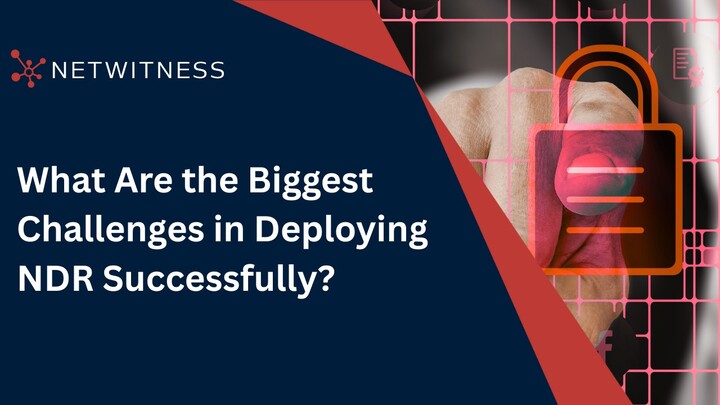What Are the Biggest Challenges in Deploying NDR Successfully?
Posted by NetWitness Security
Filed in Technology 55 views
In today’s rapidly evolving cyber threat landscape, organizations are under relentless pressure to detect and respond to attacks faster than ever before. As traditional perimeter defenses struggle to keep pace with advanced threats, Network Detection and Response (NDR) has emerged as a crucial layer of modern cybersecurity architecture. By providing deep visibility into network traffic and using AI-driven analytics to detect anomalies, NDR enables security teams to uncover stealthy intrusions that other tools often miss.
However, while the potential of NDR is undeniable, successful deployment is far from straightforward. Many organizations encounter significant technical, operational, and strategic challenges when trying to integrate NDR into their existing security ecosystems. Let’s explore the most common barriers — and how to overcome them.
1. Managing Data Overload and Network Complexity
The biggest challenge in NDR deployment often begins with data volume. Modern enterprise networks generate massive amounts of traffic across endpoints, cloud environments, IoT devices, and remote connections. Capturing, storing, and analyzing this volume of data in real time can overwhelm both technology and teams.
Many organizations struggle to balance visibility with scalability — deciding which traffic to monitor, how much data to retain, and where to deploy sensors without overloading resources.
Solution: Start with a risk-based approach. Identify critical assets and high-value network segments and deploy NDR sensors strategically. Use technologies that leverage machine learning to filter noise and highlight truly suspicious patterns. Integration with SIEM or XDR platforms can also help correlate NDR insights with other telemetry for better context.
2. Integration with Existing Security Infrastructure
NDR solutions rarely operate in isolation. They need to seamlessly integrate with SIEM, SOAR, EDR, firewalls, and identity management systems to provide a unified security posture. Unfortunately, integration can be complex due to compatibility issues, data format differences, and inconsistent APIs.
A poorly integrated NDR can lead to alert silos, where valuable threat intelligence remains trapped within one tool, reducing the efficiency of the overall security operations center (SOC).
Solution: Choose an NDR solution with open APIs and built-in connectors for popular security tools. Prioritize platforms that support bidirectional data exchange and automation workflows. Early collaboration between IT, network, and security teams during the deployment phase ensures smoother integration and fewer operational disruptions.
3. Skill Gaps and Resource Constraints
Deploying and managing an NDR solutions requires specialized expertise in network protocols, threat hunting, and anomaly detection. However, the global cybersecurity talent shortage means many organizations lack skilled analysts capable of interpreting NDR alerts or fine-tuning detection models.
Without proper expertise, teams may struggle to distinguish true threats from false positives, leading to either missed detections or alert fatigue.
Solution: Invest in continuous training for SOC analysts and incident responders. Many NDR vendors offer certifications and workshops to help teams understand their platforms better. Additionally, leveraging managed NDR or MDR (Managed Detection and Response) services can bridge skill gaps by outsourcing monitoring and analysis to specialized experts.
4. High False Positives and Alert Fatigue
AI-powered NDR systems are designed to learn “normal” network behavior and flag deviations. However, in dynamic environments — where traffic patterns change frequently due to new applications, cloud migrations, or remote access — these systems can generate a flood of false positives.
Excessive alerts not only overwhelm analysts but also delay response to real incidents, eroding confidence in the tool itself.
Solution: Calibrate detection thresholds based on baseline behavior and continuously refine models with feedback from analysts. Implement SOAR automation to prioritize and respond to alerts based on severity. Over time, the system becomes smarter, reducing noise while maintaining high detection accuracy.
5. Cost and Infrastructure Challenges
Deploying NDR across large, distributed networks can be resource-intensive and costly. Organizations often underestimate the total cost of ownership — including hardware sensors, data storage, bandwidth, and ongoing maintenance.
Moreover, the performance impact of deep packet inspection (DPI) and real-time analysis can strain existing infrastructure if not carefully planned.
Solution: Conduct a detailed cost-benefit analysis before deployment. Consider cloud-native or hybrid NDR models, which can scale dynamically without significant on-premises investment. Many modern platforms offer flexible pricing and modular deployments, allowing organizations to expand coverage gradually as needs grow.
6. Ensuring Privacy and Compliance
NDR tools inspect network traffic deeply, which can raise privacy and regulatory concerns, especially when dealing with personal or sensitive data. Misconfigurations may inadvertently expose confidential information or violate compliance mandates like GDPR or HIPAA.
Solution: Establish clear data governance policies and ensure that captured network data is encrypted, anonymized, and stored securely. Work closely with legal and compliance teams to align monitoring practices with regional and industry-specific privacy regulations.
7. Change Resistance and Organizational Buy-In
Technology alone doesn’t guarantee success — people and processes are just as critical. Some organizations face resistance from internal stakeholders who view NDR as disruptive or redundant compared to existing tools. Without executive support or clear ROI justification, NDR initiatives can lose momentum.
Solution: Build a compelling business case for NDR by demonstrating its role in reducing dwell time, improving threat visibility, and preventing costly breaches. Share early success metrics to gain buy-in from leadership and promote a culture of proactive cybersecurity.
Conclusion
Successful NDR solutions deployment requires more than just implementing technology — it demands strategic planning, skilled personnel, and strong integration across the security ecosystem. While challenges such as data overload, integration hurdles, and skill shortages can slow adoption, they are not insurmountable.
By combining automation, intelligent analytics, and human expertise, organizations can unlock the full power of NDR — transforming network visibility into actionable intelligence and ensuring faster, smarter responses to ever-evolving cyber threats.
